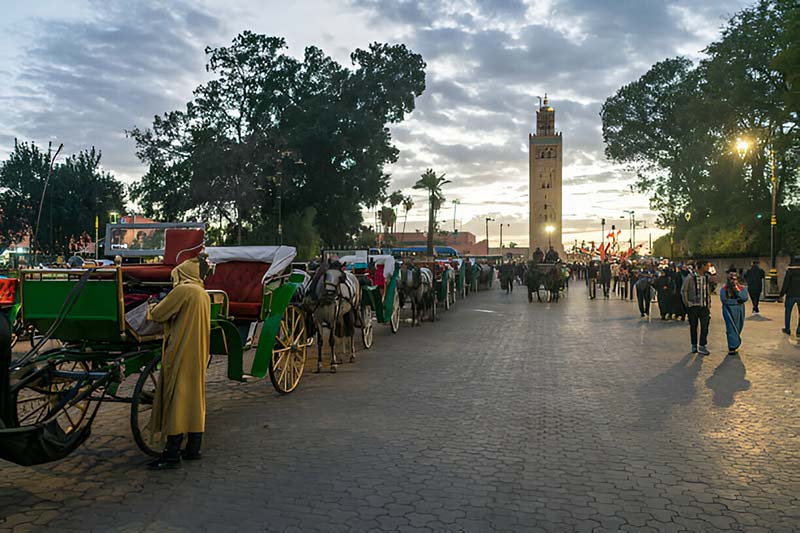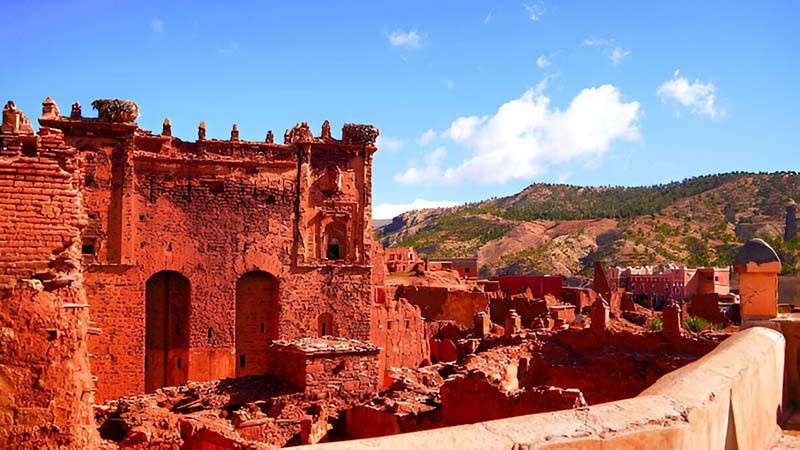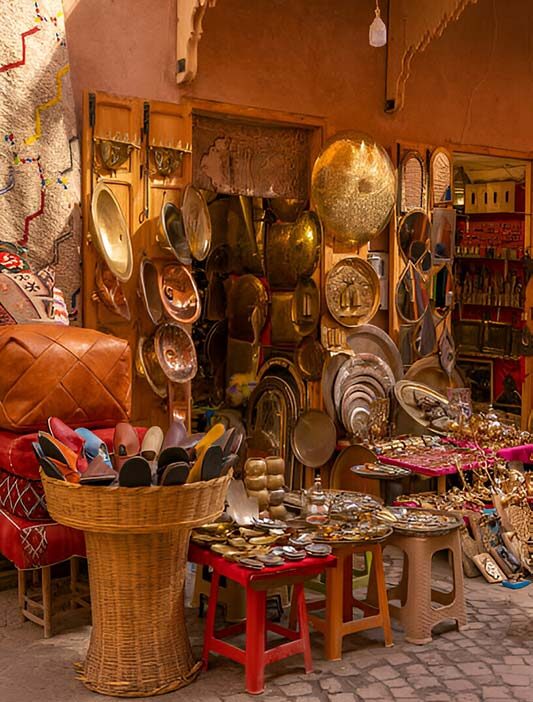The Medina of Marrakech is a lively, historic area in the heart of Marrakech, Morocco. It is a maze of narrow, winding streets filled with colorful markets, beautiful buildings, and rich history. Visitors from around the world come to explore its unique charm and vibrant atmosphere. This Medina is one of the oldest parts of Marrakech and is a UNESCO World Heritage site. It offers a fascinating glimpse into Morocco’s past and present.
Stepping into the Medina is like stepping back in time. The air is filled with the sounds of bustling markets, the smell of spices, and the sight of stunning architecture. Each corner you turn reveals a new surprise, from hidden courtyards to grand palaces. The Medina is not just a tourist attraction; it is a living, breathing part of the city where locals go about their daily lives.
To truly appreciate the Medina of Marrakech, it helps to understand its historical background. Learning about its origins and evolution gives a deeper insight into its cultural significance and the way of life within its walls. This journey through time and culture begins with a look at the Medina’s rich history.
Historical Background
The Medina of Marrakech has a long and interesting history. It was founded almost 1,000 years ago and has grown into a bustling center of life and culture. Knowing its past helps us understand why it is such a special place today.
The Medina was founded in 1070 by the Almoravid dynasty. These early builders chose the site because of its fertile land and access to water. They wanted to create a strong, beautiful city. They built high walls to protect the Medina and filled it with homes, mosques, and markets.
Over time, different rulers added their own touches to the Medina. The Almohads, who came after the Almoravids, built the famous Koutoubia Mosque. Later, the Saadian dynasty added the grand Saadian Tombs. Each period of history left its mark on the Medina, making it a rich tapestry of styles and influences.
Today, the Medina is a mix of old and new. While many parts of it look much as they did centuries ago, there have been modern changes too. Efforts have been made to preserve the historical buildings and protect the Medina’s unique character. This helps keep the Medina a lively and authentic part of Marrakech.
Cultural Significance
The Medina of Marrakech is more than just a place; it is a vibrant hub of culture and tradition. The customs and practices of the Medina reflect its rich history and diverse influences. Experiencing these cultural aspects helps visitors understand the true spirit of Marrakech.
Traditional Practices and Customs
In the Medina, many traditional practices are still alive. For example, people often visit the hammam, a type of public bath, to relax and socialize. This custom has been part of daily life for centuries. Another tradition is the use of natural ingredients in cooking, which you can see in the many spices and herbs sold in the markets.
Festivals and Celebrations
Festivals and celebrations are a big part of life in the Medina. One of the most important is the annual Marrakech Popular Arts Festival, where musicians, dancers, and artists from all over Morocco come to perform. During Ramadan, the Medina is filled with special foods and nightly gatherings as people break their fast together. These events bring the community together and keep traditions strong.
- Annual Festivals
The Marrakech Popular Arts Festival is a colorful and lively event. It showcases traditional music, dance, and crafts. This festival is a great way to see the rich cultural heritage of Morocco in one place.
- Cultural Events and Activities
Throughout the year, the Medina hosts various cultural events. These include storytelling sessions, traditional music performances, and art exhibitions. Each event offers a glimpse into the Medina’s vibrant cultural scene.
Landmarks and Attractions
The Medina of Marrakech is filled with amazing landmarks and attractions. Each one tells a story about the city’s rich past and vibrant culture. Exploring these sites is a journey through time and beauty.
Jemaa el-Fnaa
Jemaa el-Fnaa is the main square in the Medina. It is always busy with street performers, food stalls, and market vendors. During the day, you can see snake charmers and storytellers. At night, the square turns into a huge outdoor restaurant with delicious food.

Koutoubia Mosque
The Koutoubia Mosque is the largest mosque in Marrakech. It has a tall minaret that can be seen from many parts of the city. Built in the 12th century, it is a beautiful example of Moroccan architecture. Non-Muslims cannot enter the mosque, but they can admire its beauty from the outside.
Saadian Tombs
The Saadian Tombs are hidden treasures of the Medina. They were built in the 16th century and discovered only in 1917. The tombs are the resting place of members of the Saadian dynasty. The architecture is stunning, with intricate carvings and colorful tiles.
Bahia Palace
Bahia Palace is a splendid 19th-century palace. It was built for a wealthy nobleman and has beautiful gardens, courtyards, and rooms decorated with fine details. Walking through the palace feels like stepping into a fairy tale.
Ben Youssef Madrasa
Ben Youssef Madrasa is an old Islamic school. It was built in the 14th century and is known for its beautiful courtyard and intricate decorations. The school was once the largest in North Africa, and students came from all over to study there.
The Souks
The souks are the bustling markets of the Medina. They are divided into different sections, each specializing in different goods. You can find spices, textiles, pottery, and much more. The souks are a great place to buy souvenirs and experience the lively atmosphere of Marrakech.

El Badi Palace
El Badi Palace is a large palace that was once filled with gold and precious materials. Now, it is mostly ruins, but it still impresses with its vast courtyards and high walls. It is a wonderful place to explore and imagine its past glory.
Almoravid Koubba
The Almoravid Koubba is one of the oldest buildings in Marrakech. Built in the 12th century, it was used for ablutions before prayer. It is a small but fascinating structure with unique architectural details.
Majorelle Garden
Majorelle Garden is a peaceful oasis created by French artist Jacques Majorelle. It has beautiful plants, fountains, and a bright blue villa. It is a lovely place to relax and enjoy nature.
Local Traditions and Daily Life
The Medina of Marrakech is not just a place to visit; it is a place where people live and follow traditions. These customs and daily activities give the Medina its unique character.
Daily Market Life
The markets, or souks, are the heart of the Medina. Every day, vendors set up stalls selling spices, fabrics, pottery, and more. Shoppers haggle over prices, creating a lively and bustling atmosphere. It is a place where you can see and feel the pulse of the city.
Artisan Crafts and Workshops
Artisans in the Medina are skilled in traditional crafts. You can find workshops where people make carpets, jewelry, leather goods, and metalwork. Watching these craftsmen and craftswomen at work shows how important these skills are to the local culture.
Culinary Traditions
Food is a big part of life in the Medina. Traditional dishes like tagine and couscous are prepared with fresh, local ingredients. Street food is also popular, with vendors selling tasty snacks like kebabs and pastries. Sharing a meal is a way to connect with the rich culinary heritage of Morocco.

Travel Tips and Recommendations
Visiting the Medina of Marrakech can be an exciting adventure. Here are some tips to help you enjoy your trip and make the most of your experience.
Best Times to Visit
The best time to visit the Medina is during spring (March to May) and fall (September to November). The weather is pleasant, not too hot or cold. Avoid the summer months, as it can be very hot, making it hard to walk around and explore.
Navigating the Medina
The Medina is a maze of narrow streets. It is easy to get lost, but that is part of the fun. Carry a map or use a GPS app on your phone. Look for landmarks like the Koutoubia Mosque to help you find your way. Don’t be afraid to ask locals for directions; they are usually very helpful.
Safety Tips and Advice
The Medina is generally safe, but it is always good to be careful. Keep your belongings close and be aware of your surroundings. If you feel unsure, join a guided tour. It is a great way to learn more about the Medina and stay safe.
- Keep your valuables close and secure.
- Stay aware of your surroundings at all times.
- Avoid wandering alone at night.
- Use a map or GPS to navigate.
- Ask locals or shopkeepers for directions if needed.
- Consider joining a guided tour for added safety and information.
Shopping and Dining Experiences
The Medina of Marrakech is famous for its shopping and dining. There are many places to find unique items and delicious food. Here are some tips to make your experience great.
Top Souks and Markets
The souks are the main shopping areas in the Medina. Each souk has its own specialty. Semmarine is great for clothes and fabrics. El Kebir is known for spices and food. The Souk Haddadine is the place to go for metalwork and pottery. Take your time to explore and enjoy the vibrant atmosphere.
| Souk Name | Specialty | Description |
| Souk Semmarine | Clothes and Fabrics | Offers a variety of textiles, from traditional garments to modern fabrics. |
| Souk El Kebir | Spices and Food | Known for a wide range of spices, dried fruits, and local delicacies. |
| Souk Haddadine | Metalwork and Pottery | Specializes in metal goods like lamps, teapots, and handcrafted pottery. |
Must-Try Local Foods
Trying local food is a must in the Medina. Start with a traditional tagine, a slow-cooked stew with meat and vegetables. Couscous is another popular dish, usually served with a rich sauce and vegetables. For a sweet treat, try Moroccan pastries like baklava or chebakia, which are made with honey and spices.
Best Dining Spots in the Medina
There are many great places to eat in the Medina. Some of the best are small, family-run restaurants called riads. These offer homemade Moroccan dishes in a cozy setting. The food stalls in Jemaa el-Fnaa square are also popular, offering a variety of tasty and affordable options.
Conclusion
The Medina of Marrakech is a unique and fascinating place to visit. Its rich history, vibrant culture, and beautiful landmarks make it a must-see destination. Exploring the Medina offers a glimpse into the past and a chance to experience the lively atmosphere of Marrakech today.
From the bustling Jemaa el-Fnaa square to the peaceful Majorelle Garden, the Medina has something for everyone. The traditional practices, delicious food, and friendly people make it a welcoming place for visitors.
Remember to take your time exploring the Medina. Enjoy the sights, sounds, and smells. Be respectful of the local culture and traditions. This will make your visit even more memorable.
